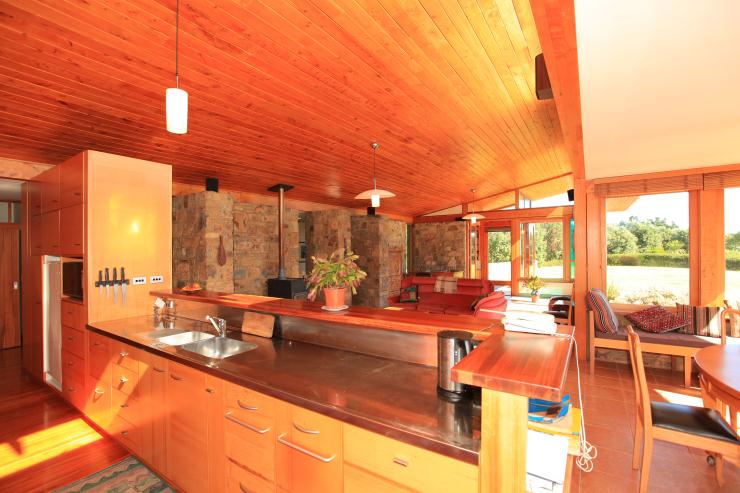Are you renovating your home or embarking on a new build? Ecobob has some tips for making more environmentally conscious decisions about the materials you choose, from flooring to lights. An eco-friendly house is less harsh on the environment and will provide you with a healthy and more energy efficient home, the company says.
Paint
Choose your paint carefully, because many paints can cause significant environmental harm during manufacturing. Certain paints can be harmful to your health during the time you're applying it, and while you're living in the home. Disposing of toxic paint can also cause problems.
Household paints have thousands of chemicals in them, and the most harmful chemicals are volatile organic compounds, or VOCs. VOCs are compounds that readily vapourise in the air. VOCs produce ozone, causing air pollution and a host of health issues such as; respiratory illnesses, headaches and dizziness.
Some VOCs have been linked to kidney and liver damage, according to level.org.nz.
Choose low VOC or VOC-free paint. Choosing paint with the Environmental Choice seal of approval allows you to figure out the better paint to choose. But remember that this approval is given only to certain products within the offerings of a particular brand, so while some products may have the approval, other products within the same brand line may not have that approval. In short, check everything you buy!
Low VOC or VOC-free paint options available on the market include Resene (they have a range of eco paints with low and no VOC options, and The Natural Paint Company, which has paint that ranges from 85% natural ingredients to 100% natural ingredients.

Restored 1930s Eco Bungalow - Used Resene's Environmental Choice paint range
Kitchen cabinets
While on the topic of toxic materials, kitchen cabinets are often made with chipboard, fiberboard or plywood. These materials often contain formaldehyde binders or glues that can release dangerous fumes that can have health implications.
If you're thinking about renovating your kitchen, be sure to choose formaldehyde free or low VOC options. Plywood certified by the Forest Stewardship Council, bamboo, or sustainable solid wood offer some great options.
If you are feeling particularly thrifty, find a solid wood second hand kitchen from TradeMe or a demolition centre. Sand it back, varnish it with low or no VOC varnish, and then splash out on some modern handles. It could cost you a fraction of the price compared to some kit sets from the big box stores.

A company that specialises in eco-friendly kitchens is Natural Kitchens, which manufactures solid wood cabinetry with low toxic finishes.
Flooring
There are a lot of options for flooring, which is fantastic, but for time's sake we'll keep it brief. Here a few of the more popular types presently available; including hard wood, laminates, linoleum and carpet.
Wooden floors: If wooden floors are sourced from sustainable forests then they are a great choice. Make sure they are treated appropriately and ensure that you choose a floor finish that has low or no VOCs. This is an excellent but expensive option. One way to avoid large costs is to use reclaimed wood floors from old homes. Reclaimed wood has a much lower impact on the environment and can add character to your home.
Laminated boards: Buy laminated wood products with caution. Personally, I am sceptical when some laminate flooring companies claim their products emit low VOC levels. That's after watching this Fair Go story from last year about Chinese-made hardwood floors that the buyer and builders who worked on the home felt made them ill, and formaldehyde detected in the room where they were laid. If you do buy laminate, my advice would be to avoid products made in China.
Linoleum floors: Choose linoleum over vinyl flooring, the two are not the same. Linoleum is made of natural materials, including linseed oil, pine resins, limestone and wood flour backed with natural jute. It is inherently antimicrobial and can be safely composted. Vinyl on the other hand is based on non-renewable chemical compounds and contains VOCs, according to Smarterhomes.org.
Carpet: The option for carpets? Wool or synthetic.
Wool carpets have some advantages, such as the wool being manufactured in New Zealand. Wool is a natural fabric that if sourced here has low carbon miles and can be easily be recycled. But wool carpets can cause issues for allergy suffers. It should be noted, wool carpet manufacturers sometimes use metal compounds and chemicals during the wool scouring and dyeing process.
Traditional nylon carpets are made from petrochemicals that cannot be recycled. Recently, there has been new fibres introduced to the nylon carpet market; plastic bottles and corn starch derived materials. Synthetic carpets can be stain resistant, hard wearing, long lasting and allergy free.
Also check for the VOC levels in carpets, and check what the carpet backing and underlay is made from, i.e. felt, natural latex or jute, rather than foamed polyurethane.

Environmental Choice certified carpet used in the 10 Star Superhome in Christchurch
Insulation
While it is important to pick an insulation product that is made of environmentally responsible materials, you should also choose insulation with a high R-value. An R-value is a rating system that basically measures the insulation's thermal resistance. The higher the R-value, the more thermal resistant it is.
Homestar rating scheme recommendations for a 6 star rated home should have ceiling insulation with an R-value of 3.6 (the building code recommends North Island 2.9 and South Island 3.3), Homestar also recommends an R-value of 2.8 for the walls (building code recommends North Island 1.9 and South Island 2.0).
A lot of big brands are great at sourcing recycled materials for their insulation; Green Stuff is made of 85% recycled PET plastic. Pink Batts and Earthwool are made up of 80% recycled glass, while Mammoth insulation is made from 100% recycled polyester.
Rain water collection
There are some great systems out there for using rainwater in your home, or recycling grey water. But these systems can come with a large up front cost that may not be accessible for everyone.
DIY rainwater collection kits are simple to set up, they are cheap, and make for some guilt free watering of the garden. And best of all, they look great! Like this one, featured on the 9 star home in Christchurch, designed by Bob Burnett.

You can purchase one of these wine barrel rain water kits from Barry's Barrels. They come with all the fittings you need and installation instructions are included.
Lighting
There's no excuse not to go with LED lights these days. They use 80% less energy than incandescent lights. The price has dropped significantly and while they may not be as cheap as incandescent bulbs, they are a great investment. New Zealanders spend 12% of their power bill on lighting in their homes, and LED lights could reduce that spend by up to 2.5%.
You can now place insulation over downlights, where traditionally you would have had to leave a gap in ceiling insulation above the lights. This can now be achieved as LED lights run at a much lower temperature.
You can retrofit your home with a wide range of bulbs, from Edison style screw bulbs to bayonet bulbs and downlights. They are available in warm or cool light. Vintage style filament LED lights look amazing and cast an even better light. Ecobob.co.nz has a selection available to purchase.
You can get LED lights from a variety of retailers: Mitre 10, Lighting Plus, and online stores like LED by Ecobulb.
Choosing eco-friendly options when acquiring materials for your home is easy and much more fun than going the traditional route. For more information about eco home materials along with some great examples of eco homes around New Zealand, check out Ecobob.co.nz.
Kristy Hoare is the managing director of Ecobob and My Solar Quotes.
Read more

Keeping your waste levels at a minimum requires a keen mind. The bad news is the ‘system' is set up to facilitate the use of single-use plastics. There's no question that plastic pollution is a hug...

Welcome to the latest instalment of our Wellness Warriors series, where we catch up with some of Australia's most inspiring wellness personalities to learn more about them and their top tips for li...






